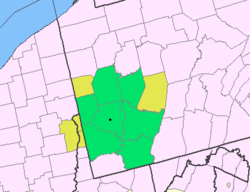2000 census
As of the census of 2000, there were 32,667 people, 13,678 households, and 9,506 families living in the county. The population density was 394 inhabitants per square mile (152/km2). There were 14,728 housing units at an average density of 178 units per square mile (69 units/km2). The racial makeup of the county was 96.42% White, 2.30% Black or African American, 0.12% Native American, 0.35% Asian, 0.01% Pacific Islander, 0.12% from other races, and 0.69% from two or more races. 0.74% of the population were Hispanic or Latino of any race.
There were 13,678 households, out of which 26.40% had children under the age of 18 living with them, 54.70% were married couples living together, 10.70% had a female householder with no husband present, and 30.50% were non-families. 26.60% of all households were made up of individuals, and 12.50% had someone living alone who was 65 years of age or older. The average household size was 2.36 and the average family size was 2.83.
In the county, the population was spread out, with 20.80% under the age of 18, 7.20% from 18 to 24, 27.10% from 25 to 44, 26.40% from 45 to 64, and 18.40% who were 65 years of age or older. The median age was 42 years. For every 100 females there were 92.40 males. For every 100 females age 18 and over, there were 89.40 males.
The median income for a household in the county was $33,759, and the median income for a family was $40,719. Males had a median income of $34,813 versus $19,100 for females. The per capita income for the county was $17,724. About 9.00% of families and 11.10% of the population were below the poverty line, including 16.10% of those under age 18 and 7.10% of those age 65 or over.
2010 census
As of the 2010 United States census, there were 30,676 people, 13,297 households, and 8,732 families living in the county. [16] The population density was 371.3 inhabitants per square mile (143.4/km2). There were 14,541 housing units at an average density of 176.0 units per square mile (68.0 units/km2). [17] The racial makeup of the county was 95.7% white, 2.3% black or African American, 0.3% Asian, 0.1% American Indian, 0.2% from other races, and 1.3% from two or more races. Those of Hispanic or Latino origin made up 1.0% of the population. [16] In terms of ancestry, 21.1% were German, 18.7% were Irish, 15.6% were Italian, 12.5% were English, 8.0% were Polish, and 6.2% were American. [18]
Of the 13,297 households, 26.6% had children under the age of 18 living with them, 48.9% were married couples living together, 12.2% had a female householder with no husband present, 34.3% were non-families, and 29.5% of all households were made up of individuals. The average household size was 2.29 and the average family size was 2.80. The median age was 45.3 years. [16]
The median income for a household in the county was $38,565 and the median income for a family was $46,978. Males had a median income of $40,961 versus $28,915 for females. The per capita income for the county was $23,118. About 11.2% of families and 14.8% of the population were below the poverty line, including 23.2% of those under age 18 and 7.0% of those age 65 or over. [19]






